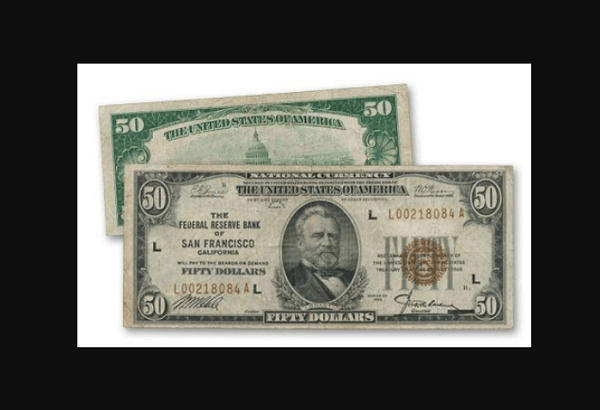1929 50 Dollar Bill Value – The 1929 $50 bill is a fascinating piece of American currency with a unique feature that sets it apart from other bills of its time. The distinct brown seal on this national currency, also known as a Federal Reserve Bank Note, is a symbol of the changing financial landscape of the United States during the late 1920s.
In this blog post, we will take a closer look at the 1929 $50 bill and its value, as well as the significance of the brown seal that adorns it.
During the year 1929, two distinct types of fifty dollar bills were issued in the United States. These bills were known as the Federal Reserve Bank Notes and the National Bank Notes.
The primary difference between the two lies in the statement on the front of the bill, indicating whether it was issued by a Federal Reserve Bank or a National Bank.

So, let’s explore the history and features of this intriguing piece of currency.
Federal Reserve Bank Notes Value
Most 1929 Series $50 Federal Reserve Bank Notes are worth around $75 and in very good condition, which is quite remarkable considering its age.
In very fine conditions, the value increases to around $100, and in uncirculated conditions with an MS 63 grade, the price can reach as high as $350.
However, it’s worth noting that bills issued by the Federal Reserve Bank of Dallas are more valuable. Additionally, keep an eye out for star notes, as they often sell for higher prices.
So if you stumble upon a 1929 50 dollar bill, take a moment to appreciate its historical significance and potential value.
National Bank Notes Value
National Bank Notes from 1929 are an interesting piece of national currency. There were two types issued, Type 1 and Type 2, and they look quite similar, so it’s important to closely examine the details.
The key difference between the two is that Type 2 bills have the bank charter number on the lower left and upper right of President Grant’s portrait.
The value of these bills will largely depend on the type and condition. In very good condition, Type 1 bills are worth around $95, while Type 2 bills are worth around $125.
In very fine condition, Type 1 bills are valued at approximately $150, and Type 2 bills at around $300.
If you come across an uncirculated Type 1 bill with an MS 63 grade, its value could be around $625, while an uncirculated Type 2 bill with the same grade could be worth around $950.
To preserve the value of these valuable bills, it is recommended to keep them inside currency holders.
1929 50 Dollar Bill Grading System
To grade the condition of a 1929 $50 bill, there are a few key categories to consider. A note that is classified as “very good” has likely been in circulation for quite some time and shows signs of wear.
This could include tears along the edges, discoloration, or a generally limp appearance.
On the other hand, a note classified as “very fine” has also been in circulation but for a shorter duration. It will still maintain its crispness, although there may be some creases, folds, or light smudges present.
The highest grade a 1929 $50 bill can achieve is “MS 63 choice uncirculated,” indicating that the note shows no signs of ever being in circulation.
Determining the value of a 1929 $50 bill, and its grade is an important factor to consider.
The grading system allows collectors to accurately assess the condition of the bill and determine its worth within the realm of national currency from 1929.
The Mystery and History Behind the 1929 Silver Certificate Dollar Bill Value
The 1929 $50 bill holds a fascinating history and mystery surrounding its silver certificate dollar bill value.
During this time, the United States was transitioning away from silver certificates and towards Federal Reserve Bank Notes. However, there were still a limited number of 1929 $50 bills that were printed as silver certificates.
These bills, with their distinctive blue seals, are highly sought after by collectors.
The value of a 1929 $50 bill can vary depending on its condition and rarity, but it is sure to hold a piece of American history that is worth exploring and uncovering.
Conclusion
The 1929 $50 bill holds a significant place in American currency history. Federal Reserve Bank Note or a National Bank Note, these bills provide a glimpse into the changing financial landscape of the late 1920s.
With values ranging from $75 to $350 for Federal Reserve Bank Notes, and $95 to $950 for National Bank Notes, these bills are not only historically valuable but also potentially lucrative for collectors.
The distinct brown seal and unique features of the 1929 $50 bill make it a captivating piece of currency that is worth exploring and appreciating for its overall worth and historical importance.